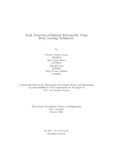| dc.contributor.advisor | Mostakim, Moin | |
| dc.contributor.advisor | Parvez, Mohammad Zavid | |
| dc.contributor.author | Gomes, Veronica Jessica | |
| dc.contributor.author | Alavee, Kazi Ahnaf | |
| dc.contributor.author | Sarda, Anirudh | |
| dc.contributor.author | Akhand, Zebel-E-Noor | |
| dc.date.accessioned | 2022-01-12T06:00:18Z | |
| dc.date.available | 2022-01-12T06:00:18Z | |
| dc.date.copyright | 2021 | |
| dc.date.issued | 2021-10 | |
| dc.identifier.other | ID 20241053 | |
| dc.identifier.other | ID 17241013 | |
| dc.identifier.other | ID 21341051 | |
| dc.identifier.other | ID 17201124 | |
| dc.identifier.uri | http://hdl.handle.net/10361/15869 | |
| dc.description | This thesis is submitted in partial fulfillment of the requirements for the degree of Bachelor of Science in Computer Science and Engineering, 2021. | en_US |
| dc.description | Cataloged from PDF version of thesis. | |
| dc.description | Includes bibliographical references (pages 33-35). | |
| dc.description.abstract | We, humans, are the bearer of diseases. While most of them have a thoroughly
researched and contemplated solution set, some of them do not. Diabetes is one of
those common diseases that do not have a clear solution but has ways to minimize
its e ects. It is a globally prevalent condition that leads to several complications in-
cluding those that are deadly. One of those intricate complexities includes Diabetic
retinopathy (DR), a human eye disease that may a ect one or both eyes hamper-
ing the functionality and leading to compromised vision and eventually, permanent
blindness. Thus, detection of diabetic retinopathy in the primitive stages will help
reduce the chances of getting visually impaired, following proper treatment and
other necessary precautions. The prime objective of our paper is to take aid from
the state-of-the-art models which are pretrained on di erent images and also to pro-
pose a basic CNN model that will have comparative results. To be more precise, we
have used transfer learning models like DenseNet121, Xception, Resnet50, VGG16,
VGG19, and Inception to classify the data based on single-label and multi-label. In
our approach, single-label classi cation using categorical cross-entropy and softmax
function works better as we reached the best accuracy, precision, and recall values
using the approach. In our case, Xception has reached an accuracy of 82% which
is a state-of-the-art result for the used dataset. In addition, our proposed model
reached an accuracy of 71% which worked better than some of the transfer learning
models. Finally, most of our approaches classi ed the data correctly even though
the dataset is very unevenly distributed. | en_US |
| dc.description.statementofresponsibility | Veronica Jessica Gomes | |
| dc.description.statementofresponsibility | Kazi Ahnaf Alavee | |
| dc.description.statementofresponsibility | Anirudh Sarda | |
| dc.description.statementofresponsibility | Zebel-E-Noor Akhand | |
| dc.format.extent | 35 pages | |
| dc.language.iso | en | en_US |
| dc.publisher | Brac University | en_US |
| dc.rights | Brac University theses are protected by copyright. They may be viewed from this source for any purpose, but reproduction or distribution in any format is prohibited without written permission. | |
| dc.subject | Data preprocessing | en_US |
| dc.subject | Transfer learning | en_US |
| dc.subject | Convolutional neural network | en_US |
| dc.subject | Xception | en_US |
| dc.subject | Inception | en_US |
| dc.subject.lcsh | Cognitive learning theory (Deep learning) | |
| dc.subject.lcsh | Diabetic retinopathy | |
| dc.subject.lcsh | Electronic data processing--Data preparation 286 906984
Engineering | |
| dc.title | Early detection of diabetic retinopathy using deep learning techniques | en_US |
| dc.type | Thesis | en_US |
| dc.contributor.department | Department of Computer Science and Engineering, Brac University | |
| dc.description.degree | B. Computer Science | |

